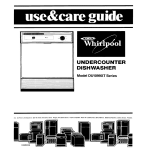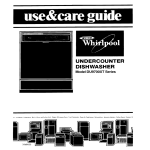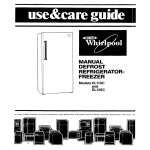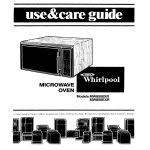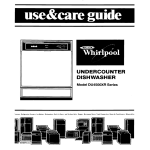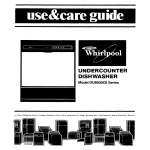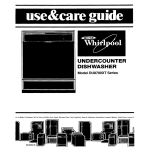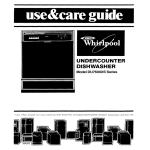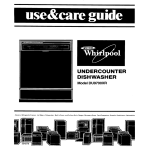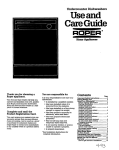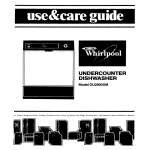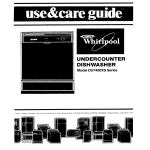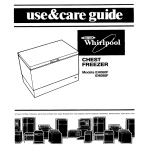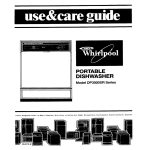Download Whirlpool DU1099XT User's Manual
Transcript
UNDERCOUNTER
DISHWASHER
Model DU1099XT Series
Contents
-,
Page
jJ--
BEFORE YOU USE YOUR DISHWASHER
IMPORTANT SAFETY INSTRUCTIONS
PARTS AND FEATURES
FOR BEST RESULTS
‘he F ,tering Svsten!
Qutef Iperatlng
T~pi
PROPER LOADING
‘op R XK LocIdIng
Bettor 1 Rack Loading
SIlverdare Basket Loading
ADDING DETERGENT
‘c
s
J
7
;
5
7
~1988 Whirlpool
BEFORE STARTING YOUR DISHWASHER.
STARTING YOUR DISHWASHER
Selecting a Cycle
HEAT DRY or AIR DRY
Changing
a Setting
To Add a Dish After Starting
ENERGY SAVING TIPS
SPECIAL TIPS
COMMON DISHWASHING PROBLEtis.
IF YOU NEED SERVICE OR ASSISTANCE.
WHIRLPOOL DISHWASHER WARRANTY
8
8
8
9
9
9
10
11
12
15
16
Corporation
Before you use your dishwasher
It is Your personal
responsibility
and obligation
to be sure your dishwasher:
Is installed by a qualified installer.
l Has been
installed where it is protected
from the elements.
l Has been
installed on a floor strong enough to support its weight.
l Has been
properly connected
to electricity, water and drain.’
l Has been
properly electrically
grounded.*
l Has had all hang
tags and temporary
labels removed.
l Is not used by children
or anyone unable to operate it properly.
l Is properly
maintained.
*See installation instructions for complete
information,
l
Parts and features
Model
DU1099XT Series
UPPER SPRAY ARM
TOP RACK
RACK BUMPER
BOTTOM RACK
SPRAY
TOWER
DETERGENT DISPEN
LOWER SPRAY ARM
USER GUIDE
(Permanent Lapel)
v
//4.*
/\‘
f
SILVERWARE BASKET
;
/
\
cll(
i
- MODEL AND SERIAL
NUMBER PLATE
(not shown)
\ I
I
DOOR COLOR PANEL
C’c:)p\.
THE OVERFLOW
PROTECTOR is
designed to prevent
too much water from
entering the dish-
~::;6:.““’
vow
Model and Serial Numbers here..
1
.Yher $10 neea servlce or cull with a questior
” .~ve ‘hjs in vmgtion ready
? Complete
Model ano Serial Numbers
date lot Itea us shown]
2, krcncx
date from sales slip
Copv this nformatlon
oook Qnd our sales
31uce
(from the
in these spaces Keep thlh
slip together
In a handy
Thank yo4 for purchasing
a Whirlpool
uct. Please complete
and mail the Owner
tration Card furnished with this product.
prodRegis-
Model
Number
Serial
Number
Purchase
Service
Date
Company
and Telephone
Number
For Best Results
Your dishwasher
cleans by spraying
a mixture of hot, clean water and detergent
against
soiled surfaces
of dishes
When a cycle
is
started, the dlshwasher
fills with water to about
the level of the heating element. This water IS
pumped
through
the rotating
spray arms,
drained
through
the filter system which removes
food and solI, and pumped
back
through the rotating spray arms. Soiled water
IS pumped
out and replaced
with clean water
during a cycie - the number of times depends
on the cycle being used
Load dishes so soiled surfaces
erful spray from rotating arms.
face
pow-
If-cleaning
filtering system and
removable
pump guard help eliminate
prerinsing by removing
food particles
from the
The filtering
system
It is not necessary
to rinse dishes before
putting them into the dishwasher.
Just remove
large pieces and quantities of food and bones.
The filtering system helps keep food particles
out of the wash water. Small particles are flushed
away as water is pumped
out. Larger particles
are trapped
in the pump guard
To remove the pump guard for cleaning
1. Wait at least 20 minutes after a cycle for
the heating element to cool down.
2. Unload and remove the bottom rack.
3. Press the outside wall of the pump guard at
the centerto
release the latch.
4. Lift out and rinse clean.
To replace the pump guard...
1. Insert pump guard legs (on inside wall) into
matching
openings
in filter screen.
2. Press down on outside wall until latch snaps
into place
3. Replace
bottom rack with rack bumpers
in
front.
Water must be hot
Check Water
Temperature
For best cleaning
and drying results, water should be at least
140°F (60°C).
1. Turn on hot water faucet nearest the dishwasher. Let water run
until it is as hot as possible.
2. Hold a candy or meat thermometer
in the stream of hot water to
measure the temperature.
3. If the temperature
is too low, have a qualified
person raise the
water heater thermostat setting.
Quiet operating tips
To avoid thumDing and clattering
noises during
operation:
l Make
sure lightweight
load items are secured
in the rack.
l Make
sure pot lids and handles. pizza pans,
cookie sheets, etc. do not touch interior walls
4
or interfere
with either of the spray arms
rotation.
l Load
dishes so they don’t touch one another.
NOTE: Keep slnk drain plugs inserted
during
dlshwasher
operatlon
to prevent noise transfer through drains.
Proper loading
Always load dishes so soiled surfaces are reached by spray from rotating spray arms.
Water musl be able to drain off completely
for best drying results. Be careful to separate
items so spray can reach all surfaces.
Top rack
The top rack is designed
for cups, glasses
and smaller items.
l
Place so open ends face down for cleaning and draining.
l
Load glasses
in top rack only. Bottom
rack is not designed
for glasses. Damoge
mav occur.
Load plastic items in the top rack only.
Only plastic
items marked
“dishwasher
safe” are recommended.
l Plastic
items can be melted in the bottom
rack.
e Items with cooked-on
or dried-on
loods
soiled surfaces facing the spray
l
loading
o Place items in the rows between
prongs.
Placing them over the prongs can lead
to breakage.
l
Be sure lightweight
items are held firmly
in place.
l China,
crystal and other delicate
items
must not touch each other during dishwasher operation.
Damage
may occur.
l
Small bowls, pans and other utensils con
be placed
in the top rack.
should
be loaded
in the bottom
rack with
Bottom
l
l
l
rack loading
Make sure pot handles and other items do not
stop rotation of either the upper or lower spray
arm. Spray arms must move freely.
Load items so they do not block or cover spray
tower.
Securely place heavily soiled cookware
face
down in rack.
A
‘\, I’,
Place plates, soup bowls, etc., between
prongs and facing the spray.
l
r
Silverware basket loading
\ \
UTENSIL LOAD
jacl the <lIverware basket while Its In or
ou’ of the sott3m rack The loaded
basket
should be !n the right front corner of the
bottom rack
NO
YES
Load forKs and swoons so they don’t
nest together.
Spray can’t reach nested
items
MIX items in each section of the basket
with some pointing up and some down.
Small items -baby
bottle caps, jar lids,
etc - can be put in any Section.
. Load cookie sheets, cake pans and other
large items at sides and back. Loading
such items in front may keep water spray
from reaching
detergent
dispenser.
NOTE:
Do not load glasses, cups or plastic Items
in the bottom rack.
l
When lower rack is removed,
replace
with bumpers in front.
l
L
Make sure sharp items (knives. forks,
skewers, etc.) are put in point down. Make
sure long Items do not stop the upper
spray arm from turning.
Adding detergent
The kind and amount of dishwasher
detergent
you use is an important
getting your dishes clean. Read this section carefully.
1 The detergent
Use automatic
dlshwasher detergent
only.
Other detergents
are
too mild and much too
sudsy
to work
In the
dishwasher.
Different
brands
of
dishwasher
detergent
have different
amOUntS
of phosphorus.
Phosphorus softens
water
and
helps
prevent
Water
spots on dishes.
COVER LATCH
COVER
Do not add detergent
until you are ready
to
wash. Fresh automatic
dishwasher
detergent
is necessary
for best
washing
results.
Store
detergent
tightly closed
in a cool dry place.
detergent
dispenser
The detergent
dispenser has one section with
a cover and one without.
l
Put detergent
in both sections for cycles with
two washes.
l
Put detergent
in the covered
section only for
cvcles with one wash.
l
Push the cover down
until it is latched.
The cover opens automatically
when the main
wash starts. Detergent
in
the open section
falls
into the dishwasher
when the door is closed.
If water is hard and
phosphorus
content
is
low (6.0% or less], you
may need to use more
detergent or use a brand
with a higher phosphorus
content (8.7% or higher).
How much
part of
J
Use covered
LIGHT Cycle
section
for...
1’ Use both
sections for..
NORMAL Cycle
to use
The amount of detergent
to use
depends
on the hardness of your
water. If too little is used, dishes won’t
be clean. However, if too much is
used in soft water, glassware
will ..
begin to etch
Find out your waters hardness by
asking
your local water department, water softener company
or
county extension agent.
l
l
l
HARD -Fill
1 or both sections to top
is 8 or more grains of
MEDIUM - Fill 1 or both sections to
middle line if water is 5 to 7 grains of
SOFT - Fill 1 or both sections to
bottom
line if water is 0 to 4 grains
hardness
of
7
Before starting
your dishwasher
-I7
1. Read “Important Safety Instructions” on page
2 before starting your dishwasher.
2. Spin the Upper and Lower Spray Arms to
make sure nothing will stop them from turning
freely.
DRY SELECTOR SWITCH
DOOR LATCH
3. Push door firmly when closing and it will automatically
latch.
4. Run hot water at sink nearest dishwasher until
it is hot. Turn it off.
Starting your dishwasher
NORMAL WASH cycle...
1. Select a drying option.
2. Turn Cycle Control Knob clockwise to
dot marked NORMAL. The dishwasher
will automatically start that cycle.
LIGHT WASH cycle...
RINSE & HOLD cycle...
1. Select a drying option.
1. Select AIR DRY OPTION only.
2. Turn Cycle Control Knob clockwise
to dot marked RINSE& HOLD.The dishwasher will automatically start that
cycle.
2. Turn Cycle Control Knob clockwise
to dot marked LIGHT.The dishwasher
will automatically start that cycle.
Selecting
a cycle
NORMAL WASH Cycle
A double wash for normal to heavily soiled loads. (The Energy Guide
Label data is based on this cycle.)
Cycle time is about 65 minutes.
LIGHT WASH Cycle
For normal, everyday
soiled loads
Cycle time is about 60 minutes.
RINSE & HOLD Cycle
For rinsing a few items to be washed
one or more days later. Cycle time
is about 10 minutes.
Use AIR DRY only.
HEAT DRY or AIR DRY?
If the HEAT DRY Option is selected, air in the
dishwasher
is heated during the “dry” part of
the cycle.
If the AIR DRY Option is selected, air in the
dishwasher is not heated. Using thisoption helps
save energy, but dishes take longer to dry (over-
night] and some water spotting
may result.
Some items (such as plastics) may need towel
drying.
For best results, use a solid rinse aid.
Changing a setting
You can change
a setting anytime
during
any cycle.
1. Lift up on the door latch to unlatch the door
and stop the cycle. Don’t open the door until
the spray arms stop spinning.
2. Turn the Cycle Control Knob clockwise to the
cycle you want.
3. Be sure the detergent
dispensers
are filled
properly for the new cycle.
4. Press door firmly to latch it. The dishwasher
will automatically
start the new cycle.
To add a dish after starting
1. To be sure the added
item is washed and
rinsed, make sure the Cycle Control Knob
has not passed LIGHT.
2. Lift up on the door latch to unlatch door to
stop the cycle. Don’t open the door until the
spray arms stop spinning.
3. Open the door and add the dish.
4. Close the door. Do not latch it. Wait 30 seconds for air in the dishwasher to warm up. This
helps reduce the amount of moisture that
can come from the vent when restarting the
cycle.
5. Press door firmly to latch it. The dishwasher
will automatically
start where it stopped.
9
Energy saving tips
You can help save energy
if you:
1. Wash full loads. Running a half-filled
dishwasher uses the same amount of electricity
and hot water as a fully loaded machine.
2. Use the LIGHT WASH Cycle for normally
soiled loads. It uses less hot water and energy
than NORMAL WASH.
3. Air dry dishes
drying
cycle.
(overnight).
4. load correctly
for best washing results. Incorrect loading
may cause poor washing
and the need to rewash all or part of the
load.
when you don’t need a rapid
Allow longer drying
times
5. Don’t pre-rinse
normally
soiled dishes. Select the correct cycle for the load and use
the recommended
amount of detergent
for
good washing results without hand rinsing.
6. Use your dishwasher
during off-peak hours.
Local utilities
recommend
this to avoid
heavy usage of energy at certain times of
day.
7. Kitchen cleanup
can be done quickly and
efficiently through the use of your dishwasher.
Most appliance
parts that can fit in the dishwasher can be cleaned
by it. Burned-on soil,
however, should be cleaned
by hand.
IO
Special tips on dishwasher use
Remember,
use your dishwasher
only for the job it was designed
to do.
Some items are not dishwasher
safe or may require special
care.
Read these special tips for the following
items:
AhUUiUUlU:
Aluminum loses its bright, shiny appearance
and darkens in color due to minerals
the water and the alkalinity of the dishwasher detergent. Colored aluminum may fade.
in
TIPS: If washed in the dishwasher
avoid placing directly in front of detergent
dispenser where
it could be sprinkled
with undissolved
detergent,
causing spotting, pitting, and discoloration.
Follow utensil manufacturers’
cleaning
instructions.
China:
Hand-painted,
metal-trimmed,
and antique china fade due to high water temperatures
and alkaline detergent
solution in the dishwasher. NOTE: Delicate,
antique
items should not be
washed in the dishwasher.
TIPS: Load china carefully. Do not allow pieces to touch each other. Test one piece by washing it
daily in the dishwasher for several weeks. Then compare
it with the rest of the set to see if colors
have changed.
CrjStd
temperature.
dishwasher.
and decorative
@aSSeX
Crystal can break from sudden exposure to high water
Metal trim and colorful decoration
on glass will fade in time when washed in the
NOTE: Delicate,
antique
items should not be washed in the dishwasher.
TIPS: Load crystal carefully in top rack only. Be sure to load a few larger items in the bottom rack
to reduce amount of force of water spray reaching
glassware
from lower spray arm. Use the
shortest cycle.
Flatware: Salty and acidic foods may tarnish silver and stainless flatware if allowed to remain on
the utensils. A film may form on sterling silver and silver plate items washed in a dishwasher, This film is
caused by reaction of silver with chlorine in the detergent. Gold flatware
is not dishwasher
safe.
TIPS: Rinse flatware as soon as possible, especially
if it is not to be washed right away. Dishwasher
detergent may remove antique finishes. Wash by hand. Tarnish and film build-up can be removed
with silver polish.
&St
irOU
UteUSilS:
The seasoned
TIPS: Wash by hand. To re-season,
Plastics:
sensitive
Many plastics will have
and may melt or warp.
TIPS: If in doubt,
protection.
Non-stick
try one piece.
finish
UteUSilS:
TIPS: Follow manufacturers’
Wood:
Many
wooden
“Dishwasher
Place
Pewter or pewter-like
in the dishwasher,
Safe” written
in upper
Rusting will result,
fat and heat in a slow oven for an hourortwo.
on them. Some plastics
rack only. AIR DRY option
Most can be washed
provides
are heat
additional
in the dishwasher.
suggestions.
items will crack
TIPS: Do not wash cutting
dishwasher.
TIPS: To keep pewter
finish will be removed
coat with unsalted
boards,
and warp
wooden
materials:
or lose their finish
salad
bowls
or knives with wooden
May streak, discolor,
and pit.
at its very best, hand wash with mild detergent.
Dishwasher care & cleaning:
Exterior - Regular use of a soft damp cloth or sponge
and a mild detergent
is all that is necessary, in most cases,
to keep the outside of your dishwasher nice looking and
clean. Interior - Hard water minerals may cause a
white film to build-up on the inside surfaces,
especially
just beneath the door area.
Wear rubber gloves when cleaning
the dishwasher
Interior. Do not use
any type of cleanser
other than
dishwasher
detergent
because
it may cause foaming or sudsing.
handles
in the
Common dishwashing
problems
PROBLEM
CAUSED BY
SOLUTION
Spottlng
and
tllming
[hard water film)
Hard water
Fill detergent
tergent with
be necessary
To remove
dispensers
to capacity.
Use dishwasher
highest available
phosphorus
content.
to install water softener.
spots and film, try a vinegar
deMay
rinse
I. Wash and rinse load as usual. Use AIR DRY.
2. Remove all metal items.
3 Put 2 cups (500 mL] white vinegar
in a container
on the
bottom rack.
4. Run dishwasher
through a complete
washing
cycle.
Water 1s not
hot enough
Water temperature
should be at least 140 F (6O“C). Set
water heater thermostat
to a higher setting. Run water at
srnk until hot before
starting,
Not enough
detergent,
or
improper
detergent
“Old” detergent
Use more dishwasher
detergent.
Use detergent
est available
phosphorus
content.
.especially
water
Improper
Make sure dishes and glassware
are loaded
reaches all surfaces and items drain properly.
erload. Do not nest items
Make sure large items do not block spray from
detergent
dispensers.
Try a bar rinse old such as Solid Jet DRYe Follow
drrectrons.
Drying without heat may result in some spotting
and silver.
loading
No rinse aid
AIR DRY Setting
Spray arm or arms noi
rotating freely
Small particles
deposited
on
items
Dishes
used
“Old”
not dry
detergent
Use only fresh dishwasher
detergent.
Store tightly
container,
in cool, dry place. Discard old detergent.
fill dispensers
until ready to start dishwasher.
12
or
reaching
package
of glasses
Check spray arms to make sure they turn freely after loading. Be sure a utensil has not prevented
their turning.
Use only fresh dishwasher
detergent.
Store tightly closed
container,
in cool, dry place. Discard old detergent.
Do not
fill dispensers
until ready to start dishwasher.
Water is not hot
enough
Water temperature
should be at least 140-F (6O’C). Set
water heater thermostat
to a higher setting
Run water at
sink until hot before
starting.
Water pressure may
be low, dishwasher
IS
not filling properly
If water pressure
while dishwasher
Water is not hot
enough
Water temperature
should be at least 140 F (6O’C). Set
water heater thermostat
to a higher setting
Run water at
sink until hot before
starting.
Improper
Make sure dishes and glassware
are loaded
reaches all surfaces and items drain properly.
erload
Do not nest Items
loading
used
with hrghwith hard
is low, do not use water tor otner purposes
is running (to assure correct fills]
Try a bar rinse aid such as Solid Jet DRY@ Follow
dtrections
Allow more time when using AIR DRY Option,
DRY Plastic items may need towel drying.
Chipping
breaking
glassware
so spray
Do not ov-
Use more dishwasher
detergent.
Use detergent
est avarlable
phosphorus
content...especrally
water.
No rinse aid
on
closed
Do not
Not enough
detergent,
or
improper
detergent
AIR DRY Setting
Black marks
dishes
with highwith hard
so spray
Do not ovpackage
or use HEAT
Aluminum
utensils
rubbing against items
during washing
Use care In loading
aiumlnum
utenslls,
especially
any
lightweight
toil container.
Place so they do not touch
dishes. Remove
black marks with plastic
scouring
pad
and a mild abrasive
cleanser.
Improper
Do not overload
Load glasses In the top rack only. Load
between
prongs.
not over them. Glasses
loaded
over
prongs will not be supported
and may chip or break.
loodrng
PROBLEM
CAUSED BY
SOLUTION
Dishes not
washing clean
Water Is not
hot enough
Water temperature
should be at least 140°F (60°C). Set
water heater thermostat
to a higher setting. Run water at
sink until hot before
starting.
Improper
Make sure dishes and glassware
are loaded
so spray
reaches all surfaces and items drain properly.
Do not overload. Do not nest items
Make sure large items do not block spray from reaching
detergent
dispensers.
loading
Spray arm or arms not
rotating freely
Not enough
or Improper
detergent
detergent
“0ld”detergent
Water pressure may
be low, dishwasher
is
not filling properly
Check spray arms to make sure they turn freely after loading Be sure a utensil has not prevented
thelrturning.
Use more dishwasher
detergent.
Use detergent
with highest available
phosphorus
content...especially
with hard
water
Use only fresh dishwasher
detergent.
Store tightly closed
container,
in cool, dry place. Discard old detergent.
Do not
fill dispensers
until ready to start dishwasher.
If water pressure IS low, do not use water for other purposes
while dishwasher
is running [to assure correct fills).
Cloudy film on
glassware,
etching permanent
corrosion
Too much detergent
in soft water
Check for rainbow
hue on glasses. A rainbow
hue is the
first sign of etching (corrosion
of glass] Reduce the amount
of dishwasher
detergent
Use a detergent
with a lower
phosphorus
content.
Inadequate
If water pressure is low do not use water for other purposes
while dishwasher
is running (to assure correct
water fills).
Make sure dishes and glassware
are loaded
properly
to
assure adequate
rinsing and draining.
Do not overload
Dlshes &
lnterlor of
dlshwasher
Yellow or
brown
Iron or manganese
water
Rust spots on
stalnless
steel
-ORDark spots on
flatware
stalnless
steel,
sllver plate, or
sterllng
Allowing
salty or
acidic
foods such as
mayonnaise.
vinegar,
fruit juices, salad
dressings, milk
products to remain on
flatware.
Undissolved
detergent
coming In
contact with flatware
Bronze tarnish
on silverplate
SlIverplate
is worn off
Exposed base metal
takes on a bronzed
hue.
Remove
Water left in
bottom of
dishwasher
DIshwasher
cycle not
completed
Clogged
drain oir
gap
Allow
rinsing
in
Temporary
remedy:
1 Set empty dishwasher
for o “one wosh”cycle.
2 Start dishwasher
and unlatch door to stop it when it has
filled for the wash part of the cycle.
3. Add ‘4 to 1,2 cup (120 to 240 ml) of citric acid crystals
(usually available
in drugstores).
4. Close and latch door to complete
cycle.
Permanent
solution:
Instoll an iron or manganese
filter to
home water supply.
Rinse flatware
that is to stand for several
washing
[use Rinse &Hold]. Clean stained
polish and re-wash. Do not put stalnless
flatware
In the same sllverware
basket
Direct contact
between
these metals can
nent damage
to the sllver.
Remove spots with silver polish. Avoid
detergent
on wet flatware.
tarnish
dlshwasher
with silver polish
to complete
hours before
items with silver
steel and sllver
compartment.
cause perma-
spilling
Have silver
concentrated
replated
cycle
Some plumbing
codes require use of a drain air gap between an undercounter
dishwasher
and the drain system
of the house. The air gap is usually located
above the sink
or on the top of the counter near the dishwasher
to prevent
the possibility
of water backing
up from the drain into the
dishwasher
due to a plugged
drain. The drain air gap is
NOT a part of the dishwasher
and is NOT covered
by the
dishwasher
warranty.
The drain air gap should be kept
clean to Insure proper draining
of the dishwasher
If you need service or assistance,
we suggest you follow these five steps:
1. Before calling for assistance...
Performance
problems often result from little
things you can find and fix yourself without tools
of any kind.
If your dishwasher
will not run, or stops during
a cycle:
l Is the
door tightly
closed
and securely
latched?
l Has the
cycle been correctly
set.
l Is the water
turned on?
. Have you checked
your home’s main fuses or
circuit breaker box?
l Is the dishwasher
wired into a live circuit with
the proper voltage?
l If the motor
has stopped because ot an overload, it will automatically
reset itself within a
few minutes. If the motor does not start, call for
service.
If water remains in the dishwasher:
l Has the cycle
completed?
l A small
amount of remaining water is normal.
l Is drain
hose or air gap clogged?
If detergent
remains in the covered
cup:
l Is the
bottom rack in backwards?
bumpers should be at the front.]
l Is the dishwasher
detergent fresh?
l Is the cycle
completed?
detergent
(The rack
2. If you need assistance?..
Call Whirlpool
COOL-LINE”
service
assistance
telephone
number.
Dial free from
anywhere
in the U.S.:
l-800-253-1301
and talk with one of our trained Consultants. The
Consultant can instruct you in how to obtain satisfactory operation
from your appliance
or, if
service is necessary,
recommend
a qualified
service company
in your area.
3. If you need service*...
Whirlpool
has a
nationwide
network of franchised
warranty
service,
anywhere
in the United States. To locate TECHCARE service in your area, call our COOL-LINE
service assistance telephone
number (see Step
2) or look in your telephone
directory
Yellow
Pages under:
APPLIANCES.
HOUSEHOLD
MAJOR
SERVICE & REPAIR
OR
ELECTRICAL
APPLIANCES.
MAJOR - REPAIRING
8 PARTS
IVHIRLPOOL APPLIANCES
FRANCHISED TECH~CARE SERVICE
WHIRLPOOL APPLIANCES
FRANCHISED TECH&CARE SERVICE
.SF‘HI'/C'E
XVZ SERVICE CO
'23 Mdpl?
SEi?I'/~'E
XYZ SERVICE CO
123 Maple
~'o‘tfP4
v/h::s
333 3333
(‘Olff';\S/b;.s
333 9993
OR
WASHING
MACHINES,
DRYERS
8 IRONERS
SERVICING
WHIRLPOOL APPLIANCES
FRANCHISED TECH~CARE SERVICE
.SFKI'I('E
XYZ SERVICE CO
12? Maple
c ‘I~.MPAV/E.\
333 3333
4. If you have a problem?..
Call our COOL-LINE service
assistance
telephone number(see
Step 2) and talk with one of our
Consultants, or if you prefer, write to:
Mr. Robert Stanley
Division Vice President
Whirlpool Corporation
2000 M-63
Benton Harbor, Ml 49022
5. If you need FSP”
replacement parts?. .
FSP is a registered
trademark
of Whirlpool Corporation for quality parts. Look for this symbol of
quality whenever
you need a replacement
part
for your Whirlpool
appliance.
FSP replacement
parts will fit right and work right, because they are
made to the same exacting specifications
used to
build every new Whirlpool appliance.
*If you must call or write, please provide: model
number, serial number, date of purchase, and a
complete
description
of the problem. This information is needed
in order to better respond to your
request for assistance.
Notes
WHIRLPOOL”
DISWMHER
WARRANTY
LENGTH OF WARRANTY
[
WHIRLPOOL
DWOOOZ
WILL PAY FOR
FULL ONE-YEAR WARRANTY
From Date of Purchase
FSP@replacement
parts and repair laborto
correct defects
in materials or workmanship.
Service must be provided
by a
franchised
TECH-CARED service company.
LIMITED NINE-YEAR WARRANTY
Second Through Tenth Year From
Date of Purchase
FSP replacement
of the porcelain
tub and/or DURAPERM’ inner
door should they fail to contain water due to defective
materials
or workmanship.
WHIRLPOOL
WILL NOT PAY FOR
A. Service calls to:
1. Correct the installation
of the dishwasher.
2. Instruct you how to use the dishwasher.
3. Replace house fuses or correct tiouse wiring or plumbing.
B. Repairs when dishwasher
is used in other than normal, single-family
household
use.
C. Pick up and delivery. This product is designed
to be repaired
in the home.
D. Damage to dishwasher
caused by accident,
misuse, fire, flood, acts of God or use of products
approved
by Whirlpool.
E. Any labor costs during limited warranty.
not
WHIRLPOOL CORPORATION SHALL NOT BE LIABLE FOR INCIDENTAL OR CONSEQUENTIAL DAMAGES. Some states
do not allow the exclusion
or limitation of incidental
or consequential
damages
so this limitation or exclusion
may not apply to you. This warranty
gives you specific
legal rights, and you may also have other rights which
vary from state to state.
Outside the United States, a different warranty
may apply. For details, please contact your franchised
Whirlpool
distributor
or military exchange.
Part No. 3368022
~1988 Whirlpool
lkers
DIshwashers.
Printed
Corporation
Bu~ll-In Ovens and Surlace Un~ls. Ranges. Mwowave
Ovens Trash Compaclors.
Room Air Candalmners.
Oehumldihers.
Automalx
in U.S.A.
Washers. Clothes Dryers. Freezers. Relrlgeralr
















